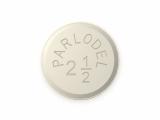| 2,5mg 30pills | 
| $130.00 $107.99 $3.60 per pill |
+ Package delivery insurance
+ Next orders 10% discount
| ADD TO CART save: $0.00 | |
| 2,5mg 60pills | 
| $208.00 $172.99 $2.88 per pill |
+ Package delivery insurance
+ Next orders 10% discount
| ADD TO CART save: $43.20 | |
| 2,5mg 90pills | 
| $280.00 $232.99 $2.59 per pill |
+ Free standard airmail service
+ Package delivery insurance
+ Next orders 10% discount
| ADD TO CART save: $90.90 | |
| 2,5mg 120pills | 
| $336.00 $279.99 $2.33 per pill |
+ Free standard airmail service
+ Package delivery insurance
+ Next orders 10% discount
| ADD TO CART save: $152.40 | |
| 2,5mg 180pills | 
| $454.00 $377.99 $2.10 per pill |
+ Free trackable courier service
+ Package delivery insurance
+ Next orders 10% discount
| ADD TO CART save: $270.00 | |
| 2,5mg 240pills | 
| 
| $545.00 $453.99 $1.89 per pill |
+ Free trackable courier service
+ Package delivery insurance
+ Next orders 10% discount
| ADD TO CART save: $410.40 |
Parlodel is a drug applied in different diseases but one of its applications is Parkinson’s disease. It contains Bromocriptine.
Pharmachologic effect
Parlodel contains Bromocriptine. This substance belongs to a stimulator of central and peripheral D2-dopamine receptors (derived from the ergot alkaloid). By inhibiting the secretion of prolactin, it suppresses the physiological lactation, helps to normalize menstrual function, inhibits the increased secretion of growth hormone, reduces the size and number of cysts in the mammary gland (by eliminating the imbalance between progesterone and estrogen).
In high doses, it stimulates the dopamine receptors of the striatum, black nucleus of the brain, hypothalamus, and the mesolimbic system. It has an antiparkinsonian effect, inhibits the secretion of STH and ACTH.
After taking a single dose, a decrease in prolactin in blood plasma occurs within 2 hours, the maximum effect reaches within 8 hours, the antiparkinsonian effect within 30-90 minutes, the maximum – within 2 hours, the decrease in GH levels within 1-2 hours, the maximum effect is achieved within 4-8 weeks of therapy.
Dosage and administration
Orally, while eating.
Menstrual disorders, female infertility: 1.25 mg 2-3 times a day, if necessary, the dose is gradually increased to 5-7.5 mg/day. Treatment should be continued until the menstrual cycle is normalized and/or ovulation is restored, for the prevention of relapse within a few menstrual cycles.
Premenstrual syndrome: treatment begins on the 14th day of the menstrual cycle from 1.25 mg/day, then the dose is gradually increased by 1.25 mg/day to 5 mg/day (before menstruation).
Hyperprolactinemia in men: 1.25 mg 2-3 times a day, gradually increasing the dose to 5-10 mg/day.
Prolactinomas: 1.25 mg 2-3 times a day, gradually increasing the dose to several tablets per day, providing the desired level of prolactin in the blood.
Acromegaly: the initial dose is 1.25 mg 2-3 times a day, then, depending on the clinical effect and the severity of side effects, you can increase the daily dose to 10-20 mg.
Lactation prevention: on the first day – 1, 25 mg 2 times a day, morning and evening, then – 5 mg (2.5 mg 2 times a day) for 14 days. Treatment should be started a few hours after birth or abortion, but not in the first 4 hours after these procedures – after stabilization of the body vital functions. 2-3 days after drug discontinuation, a slight secretion of the milk is possible, to eliminate which it is necessary to continue therapy with the same dose for another 1 week.
Postpartum tenderness of the mammary glands: 2.5 mg once, within 6–12 hours, the dose can be repeated, there is no undesirable arrest of lactation.
Benign diseases of the mammary glands: 1.25 mg 2-3 times a day, the dose is gradually increased to 5-7.5 mg/day.
Parkinson’s disease: to ensure optimal tolerance, treatment begins with a small dose of 1.25 mg once a day, preferably in the evening, for 1 week. The dose is gradually (weekly) increased by 1.25 mg, distributed into 2-3 doses per day. The therapeutic effect occurs within 6-8 weeks of treatment, otherwise, you can continue to increase the daily dose, increasing it weekly by 2.5 mg/day. The average therapeutic dose for mono – and combination therapy is 10-30 mg/day. The maximum daily dose is 30 mg.
Side effects
- Nausea, vomiting, dizziness;
- Orthostatic hypotension (rarely);
- Myocardial infarction, stroke;
- Constipation;
- Drowsiness;
- Headache;
- Psychomotor agitation;
- Hallucinations;
- Psychosis;
- Dyskinesia;
- Decreased visual acuity;
- Dry mouth (caries, periodontal disease, discomfort);
- Nasal congestion;
- Allergic reactions;
- Skin rash;
- Spasms in the calf muscles.
Prolonged use of Parlodel can cause the following side effects:
- Raynaud’s syndrome;
- confusion;
- fainting;
- peptic ulcer;
- gastrointestinal bleeding (black feces, blood in the vomit);
- retroperitoneal fibrosis (abdominal pain, decreased appetite, back pain, nausea, vomiting, weakness, rapid urination).
- Overdose
- Symptoms: headache, hallucinations, decreased blood pressure.
- Treatment: parenteral administration of metoclopramide.
Interactions
- The use of bromocriptine reduces the effectiveness of oral contraceptives.
- The drug enhances the effect of levodopa, antihypertensive drugs.
- MAO inhibitors, furazolidone, procarbazine, selegiline, ergot alkaloids, haloperidol, loxapine, methyldopa, metoclopramide, molindone, reserpine, thioxanthenes, and phenothiazines increase the plasma concentration and the risk of side effects.
- Erythromycin, clarithromycin, troleandomycin increase the bioavailability and Cmax of bromocriptine.
- Butyrophenones decrease drug effectiveness.
- The simultaneous use of ethanol results in the development of disulfiram-like reactions (chest pain, skin flushing, tachycardia, nausea, vomiting, reflex cough, throbbing headache, blurred vision, weakness, cramps).
- When combined with ritonavir, a 50% dose reduction is recommended.